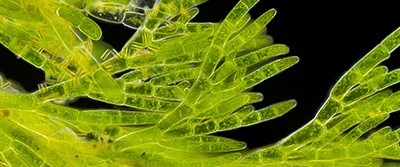Green Seaweed Fossils Date Back 1 Billion Years

By Ralph Birch
A recent study found that the oldest green seaweed on record, the ancestor of all land plants, lived about 1 billion years ago.
Scientists discovered fossils of Proterocladus antiquus in China, which may be the oldest green algae ever found. It was quite small in size, measuring just 0.07 inches in length, and could produce oxygen through photosynthesis.
“The discovery indicates that green plants we see today can be traced back to at least a billion years ago,” said Qing Tang, lead researcher and postdoctoral fellow from the Department of Geosciences at Virginia Tech University. “They started in the ocean before they expanded their territory to land.”
The Timeline
Until now, researchers didn’t have concrete proof that green algae existed one billion years ago. Computer models previously showed that photosynthesizing plants came to be sometime between the Paleoproterozoic era (2.5 billion to 1.6 billion years ago) and the Cryogenian period (720 million to 635 million years ago).
But now that researchers have fossils of these prehistoric plants, they can confidently say that photosynthesizing plants, a group known as Viridiplantae, not only lived at least 1 billion years ago but also had multicellular construction.
“Previously, the oldest widely accepted fossilized green algae was about 800 million years old,” said Timothy Gibson, a postdoctoral fellow in the Department of Earth Sciences at Dartmouth College and the Department of Geology and Geophysics at Yale University. “This work confirms what many have expected based on the existing — though sparse — fossil record, which is that green algae likely existed about 1 billion years ago.”
Tang and his colleagues discovered the fossils near Dalian City in the Liaoning province of northern China. The researchers found out about a thick pile of well-exposed sedimentary rocks that dated back about a billion years. Tang’s team took some of those rocks, mostly mudstone and shale, back to their lab at Virginia Tech for further testing.
In all, Tang and his team identified more than 1,000 specimens of the ancient algae in the rocks they collected.
Ancient Algae
Just like modern-day algae, P. antiquus features differentiated, branched cells and root-like structures. It likely played a key role in the ancient ecosystem by producing oxygen. It also may have been a source of food and shelter to other organisms.
“Most of the organisms in this period were either planktonic or lying on the sea floor,” Tang said.
P. antiquus also grew on the sea floor, which is why scientists believe it served as an ideal place for other organisms to live, hide, and rest.
Life on earth depends on photosynthesizing plants and algae for food, but land plants didn’t evolve until 450 million years ago.
“The new fossil suggests that green seaweeds were important players in the ocean long before land plants took control,” Tang said.
The Research Continues
These fossils came from an ancient ocean, but there is still some debate about where green algae originated.
“Not everyone agrees with us,” said Shuhai Xiao, a professor in the Department of Geosciences at Virginia Tech. “Some scientists think that green plants started in rivers and lakes, then conquered the ocean and land later.”
Green algae are not the oldest on record. There’s evidence that red algae existed over a billion years ago, and there’s scientific evidence that red and green algae came from a common ancestor.
“Although this doesn’t fundamentally change the way I’ll think about the evolution of life, the discovery of this green algae fossil helps fill an important gap and strengthens an emerging timeline for the evolution of early, complex life,” Gibson said.
Discussion Questions
- Aside from green and red, do you know of any other types of algae?
- What types of organisms lived at the same time as the green algae mentioned in the article?
Vocabulary
- algae
- photosynthesis
- multicellular
- sedimentary